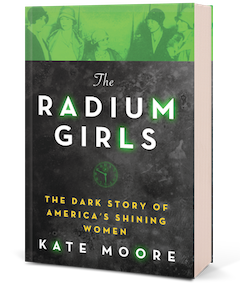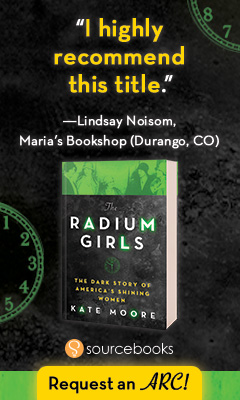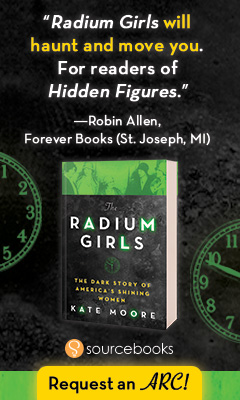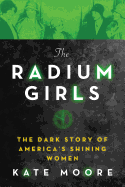Radium Girls: The Dark Story of America's Shining Women
by Kate Moore
British writer and theater director Kate Moore (Scone with the Wind: Cakes and Bakes with a Literary Twist) first encountered the stories of the Radium Girls while producing the play These Shining Lives. She was deeply moved by the 1920s and '30s-era female factory workers who, despite their class, poverty and the agonies of radium poisoning, successfully fought their employers for compensation and lobbied for health and safety legislation that still benefits workers today. When she looked to learn more about them, Moore realized no book existed about the resilient, courageous women from their perspectives, so she set out to write one herself.
In 1917, radium was a glamorous new substance, magical and expensive. It was "a magnificent cure-all"; wealthy people "drank it as a tonic; the recommended dose was five to seven glasses a day." During World War I there was a great need for luminous watch dials, and hand-painting them was one of the most desirable jobs a working-class girl could get. Most were teenagers when they started work, thrilled at their luck, proud of their new earning power. To paint the numerals, they mixed their own radium paint on their work tables, and they were taught to point their fine brushes between their lips.
When the women asked if it might be dangerous to swallow traces of the paint, they were told it was harmless. Thanks to their relatively high wages, they became the stylish glamour girls of their towns. The clinging radium dust made them glow as they walked home in the dark. They took paint home, to paint their faces and decorate the walls. One girl "painted the material all over her teeth one night before a date, wanting a smile that would knock him dead." And then they began to get sick.
Moore's personal passion for the stories of the radium girls is evident in her sympathy for them and in her deep knowledge of every detail of their personal experiences, environments and the laws they fought to change. Moore did extensive research in the United States, interviewing many of the women's families, visiting their workplaces, homes and graves in Illinois and New Jersey, and studying court documents, letters and personal diaries.
The physical and emotional suffering of these women as their radiation poisoning advanced makes for harrowing reading, and Moore describes it with all the merciless detail that one of their outraged doctors or loving relatives might want the world to know. Their bones thinned and snapped, they grew dreadful tumors, their mouths and throats rotted away and their jaw bones deteriorated. Once embedded in their bodies, the radium was impossible to remove. When one of the first girls to die was exhumed for an autopsy to prove she had died of radium poisoning, the unearthed coffin "seemed to glow with an unnatural light."
Doctors and dentists were bewildered by the symptoms and eventually grew suspicious of the true cause. Their concerns finally spread to the United States Radium Corporation, which launched an investigation in 1924 headed by a Harvard physiologist. When the findings indicated that radium was indeed dangerous, the corporation tried to cover up the research.
Legal recourse for industrial diseases was extremely limited at this time, and the industry wanted to keep it that way. They did all they could to suppress scientific evidence and deny the workers' claims. But the dial painters banded together, encouraged each other and found good attorneys. They filed lawsuits for compensation and lobbied for new legislation to protect all industrial workers. As evidence and deaths mounted, the FDA and the AMA turned against radium in products and medicine. New health and safety standards concerning the material were put in place just in time to protect individuals working with radium and other dangerous materials during World War II. The Radium Girls follows these young women through their trials and tribulations at a breakneck pace while providing impressive details in character lists, notes and citations.
The poor, working-class Radium Girls stood up to power and wealth together. And even though no one could save most of their lives, they won justice for themselves and future generations of industrial workers. --Sara Catterall








